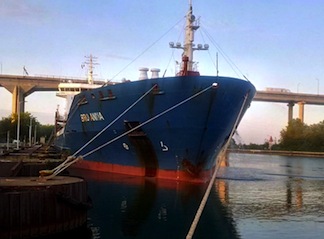The following is text of a news release from the Transportation Safety Board of Canada (TSB):
(QUEBEC CITY) — The Transportation Safety Board of Canada (TSB) has released its investigation report on the August 2017 loss of power and subsequent grounding of the chemical product carrier Bro Anna in Beauharnois, Quebec.
On Aug. 4, 2017, at 0330, during an approach to the Eisenhower Lock in the St. Lawrence Seaway, the vessel had experienced a bow thruster failure, and auxiliary generator No. 3 went offline. This occurrence was attributed to the bow thruster's thermal overload protection system.
Electrical system
Bro Anna's electrical system is designed so that the shaft generator provides electricity solely to the bow thruster when the vessel is maneuvering. Power to the main switchboard electrical system is then provided by the three auxiliary generators and controlled by the power management system. During the occurrence, the shaft generator was not running and the three auxiliary generators were providing electricity to the main switchboard and bow thruster switchboard through a tie breaker. As a result, there was no standby generator available in case the electrical load increased beyond the generators' capacity.
The investigation determined that the bow thruster's local circuit-breaker trip and time delay settings differed from the manufacturer's specifications and were set to accept a higher load than those of the bow thruster main circuit breaker.
In this occurrence, the bow thruster went into overload and the bow thruster's local circuit breaker was able to accept a higher load due to the incorrect trip and time delay settings. The bow thruster's main circuit breaker received the overload, and the power management system's only option to safely control that overload was to open the main circuit breakers for the three auxiliary generators. This caused the blackout and shut down the main engine, the bow thruster, and the steering gear. The three auxiliary generators kept running while the emergency generator started and connected to the emergency switchboard. The investigation was unable to determine the source of the overload.
Routine inspections and repairs
The investigation determined that the crew had conducted periodic inspections, maintenance, and repairs on the bow thruster prior to the occurrence. The investigation was unable to determine why the bow thruster's local circuit breaker did not meet the manufacturer's settings, or when the original settings were changed. Under the vessel's inspection regime, the bow thruster's local circuit breaker was not subject to a periodic mandatory inspection.
Click here to read the complete report.

